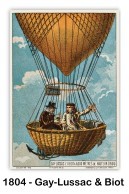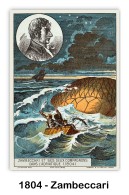

| 1700-1799 | Master Index | 1810-1819 |
1800-1809 Chronology of Aviation History
Major Aviation Events
1800
- No data
1801
- No data
1802
5 July 1802 (England) — Frenchman André-Jacques Garnerin demonstrates his Montgolfière's second English balloon ascent which includes Edward Hawke Locker. Garnerin and his wife were touring England in 1802 during the Peace of Amiens. André-Jacques ascended in his balloon from the Volunteer Ground in Grosvenor Square and made a parachute descent to a field near St Pancras. This gave rise to the English popular ballad: Bold Garnerin went up Which increased his Repute And came safe to earth In his Grand Parachute. He also made his second English balloon ascent with Edward Hawke Locker on 5 July 1802 from Lord's Cricket Ground, traveling the 17 miles from there to Chingford in just over 15 minutes and carrying a letter of introduction signed by the Prince Regent to give to anyone should he crash land. [3]
1803
1803 (England) — British Rear Admiral Charles Henry Knowles proposes to the Admiralty that the Royal Navy loft an observation balloon from a ship in order to reconnoiter French preparations in Brest to invade Great Britain. His proposal is ignored. [1]
18 July 1803 (Hamburg, Germany) — Étienne Gaspard Robertson and Lhoest climb from Hamburg (Germany) up to 7,280 m in a balloon.
Étienne-Gaspard Robert (1763-1837), often known by the stage name of “Robertson”, was a prominent Belgian stage magician and influential developer of phantasmagoria. He was described by Charles Dickens as “an honorable and well-educated showman”. Alongside his pioneering work on projection techniques for his shows Robert was also a physics lecturer and a keen balloonist at a time of great development in aviation. He designed and flew balloons in different countries around the world. On 18 July 1803 in Hamburg he set an altitude record in a Montgolfière. He spent many flights investigating meteorological activity.
Robert's two hydrogen-balloon flights in Hamburg and a third in St. Petersburg were claimed to be “scientific” by himself. In fact, he did numerous observations: Observations of barometer and thermometer, on shapes and altitudes of cloud formations, the behavior of parachutes at different altitudes, the evaporation of Ether, the electrical properties of different materials and the air, behavior of a magnetic needle, the boiling point of Water at great altitudes, sound propagation, influence of the high altitudes on animals (Pigeons and Butterflies), strength of solar radiation, the solar spectrum, gravity properties, chemical composition of the air and pressure of the air.
Nevertheless, close examination of the results shows, that many of them contradict with laws of physics, which were already known at the time of the flights. Prof. L.W. Gilbert discussed the results published by Robert in his Annalen der Physik and showed, why Robert was wrong. For example Robert claimed, that a spring scale with attached weights showed a lower weight at altitude as compared to the ground. Such an effect is existing, but only becomes apparent at altitudes in excess of 70,000 feet.
In 1806 an audience of 50,000, including the royal family, gathered at Rosenborg Castle in Copenhagen to see Robert and his balloon. Robert flew all the way to Roskilde - a remarkable feat for the time. The event made a lasting impression on Hans Christian Ørsted, an influential Danish physicist who went on to write a series of poems about the flight. ²
3-4 October 1803 (Paris, France) — Frenchman André-Jaques Garnerin covered a distance of 395 km from Paris to Clausen with his Montgolfière.
After a successful tour during the Peace of Amiens, the war between France and Great Britain resumed. Frenchman André-Jaques Garnerin and his wife were forced to pack up and return to the continent. On 3-4 October, Frenchman André-Jaques Garnerin covered a distance of 245 miles (395 km) between Paris and Clausen with his balloon. [3]
1803 (London, England) — Count Francesco Zambeccari publishes a five-volume work on ballooning and aeronautics. [1]
1804
1804 (England) — Sir George Cayley builds a model glider with moveable control surfaces. Sir George Cayley, was a prolific English engineer and one of the most important people in the history of Aeronautics. Many consider him the first true scientific aerial investigator and the first person to understand the underlying principles and forces of flight. Often known as “the father of Aerodynamics,” he was a pioneer of aeronautical engineering. Designer of the first successful glider to carry a human being aloft, he discovered and identified the four aerodynamic forces of flight-weight, lift, drag, and thrust-which are in effect on any flying vehicle. Modern aeroplane design is based on those discoveries including cambered wings. He is credited with the first major breakthrough in heavier-than-air flight and he worked over half a century before the development of powered flight, being acknowledged by the Wright brothers. He designed the first actual model of an aeroplane and also diagrammed the elements of vertical flight. [1]
August/September 1804 (France) — Experiments by physicists Joseph Louis Gay-Lussac and Jean Baptiste Biot disproved the theory that the earth's pull decreases with height. Joseph Louis Gay-Lussac (1778-1850) was a French chemist and physicist. He is known mostly for two laws related to gases, and for his work on alcohol-water mixtures, which led to the degrees
 Gay-Lussac used to measure alcoholic beverages in many countries. Gay-Lussac was born at Saint-Léonard-de-Noblat in the department of Haute-Vienne. He received his early education at the hands of the Catholic Abbey of Bourdeix. Later, in the care of the Abbot of Dumonteil he began his education in Paris, finally entering the école Polytechnique in 1798. Gay-Lussac narrowly avoided conscription and by the time of entry to the école Polytechnique his father had been arrested (due to Robespierre's Reign of Terror). Three years later, Gay-Lussac transferred to the école des Ponts et Chaussées, and shortly afterwards was assigned to C. L. Berthollet as his assistant. In 1802, he was appointed demonstrator to A. F. Fourcroy at the école Polytechnique, where in (1809) he became professor of chemistry. From 1808 to 1832, he was professor of physics at the Sorbonne, a post which he only resigned for the chair of chemistry at the Jardin des Plantes. In 1821, he was elected a foreign member of the Royal Swedish Academy of Sciences. In 1831 he was elected to represent Haute-Vienne in the chamber of deputies, and in 1839 he entered the chamber of peers. Gay-Lussac's achievements include: [1,3,5]
Gay-Lussac used to measure alcoholic beverages in many countries. Gay-Lussac was born at Saint-Léonard-de-Noblat in the department of Haute-Vienne. He received his early education at the hands of the Catholic Abbey of Bourdeix. Later, in the care of the Abbot of Dumonteil he began his education in Paris, finally entering the école Polytechnique in 1798. Gay-Lussac narrowly avoided conscription and by the time of entry to the école Polytechnique his father had been arrested (due to Robespierre's Reign of Terror). Three years later, Gay-Lussac transferred to the école des Ponts et Chaussées, and shortly afterwards was assigned to C. L. Berthollet as his assistant. In 1802, he was appointed demonstrator to A. F. Fourcroy at the école Polytechnique, where in (1809) he became professor of chemistry. From 1808 to 1832, he was professor of physics at the Sorbonne, a post which he only resigned for the chair of chemistry at the Jardin des Plantes. In 1821, he was elected a foreign member of the Royal Swedish Academy of Sciences. In 1831 he was elected to represent Haute-Vienne in the chamber of deputies, and in 1839 he entered the chamber of peers. Gay-Lussac's achievements include: [1,3,5]- 1802-Gay-Lussac first formulated the law, Gay-Lussac's Law, stating that if the mass and pressure of a gas are held constant then gas volume increases linearly as the temperature rises. This is sometimes written as V=kT, where k is a constant dependent on the type, mass, and pressure of the gas and T is temperature on an absolute scale. (In terms of the ideal gas law, k=nR/P.)
- 1804-He and Jean-Baptiste Biot made a hot-air balloon ascent to a height of 6.4 kilometers in an early investigation of the Earth's atmosphere. He wanted to collect samples of the air at different heights to record differences in temperature and moisture.
- 1805-Together with his friend and scientific collaborator Alexander von Humboldt, he discovered that the composition of the atmosphere does not change with decreasing pressure (increasing altitude). They also discovered that water is formed by two parts of hydrogen and one part of oxygen (by volume).
- 1808-He was the co-discoverer of boron.
- 1810-In collaboration with Louis Thenard, he developed a method for quantitative elemental analysis by measuring the CO2 and O2 evolved by reaction with potassium chlorate.
- 1811-Gay-Lussac recognized iodine as a new element, described its properties, and suggested the name iode.
- 1824-He developed an improved version of the burette that included a side arm, and coined the terms “pipette” and “burette” in an 1824 paper about the standardization of indigo solutions.
7 September 1804 (Italy/Adriatic Sea) — Zambeccari and two companions, Grasetti and Andreoli, ascend in Bologna attempting to cross the Adriatic, but have to be rescued after one day at sea. Count Francesco Zambeccari was an Italian aviation pioneer who launched the first (unmanned) balloon in Britain in the year 1783. His later adventures were less successful and
 Zambeccari and his companions had to be rescued from the Adriatic twice, in 1803 and 1804. The count was less lucky in 1812, when his balloon caught fire after an unsuccessful landing attempt and he perished. The image below is the eighth card from a set of ten, labeled “Collection 476, 2ème série”, issued by Romanet & Cie. in the late 19th Century, to commemorate events in ballooning history from 1795 to 1846. [1]
Zambeccari and his companions had to be rescued from the Adriatic twice, in 1803 and 1804. The count was less lucky in 1812, when his balloon caught fire after an unsuccessful landing attempt and he perished. The image below is the eighth card from a set of ten, labeled “Collection 476, 2ème série”, issued by Romanet & Cie. in the late 19th Century, to commemorate events in ballooning history from 1795 to 1846. [1]1804 — J. Kaiserer suggests making a Montgolfière maneuverable with the help of tame eagles. [1]
1805
- No data
1806
1806 (France) — Lord Cochrane flies kites from the Royal Navy 32-gun frigate HMS Pallas to spread the propaganda leaflets along the coast of France. It is the first use of an aerial device in European maritime warfare. [1]
1807
1807 (Vienna, Austria-Hungary) — Jakob Degen, a watchmaker from Vienna, experiments with an apparatus with valve-flap, flapping wings. [1]
1808
1808 (Vienna, Austria-Hungary) — Jakob Degen, a watchmaker from Vienna, tries to combine a Montgolfière with the flapping wings. [1]
1809
September 1809 (England) — Sir George Cayley published his seminal paper On Aerial Navigation, setting out for the first time the scientific principles of heavier-than-air flight. [1]
1809 (Vienna, Austria-Hungary) — Jakob Degen, propels a hydrogen-filled balloon by flapping large ornithopter-style wings. [1]
Works Cited
- Wikipedia, Timeline of Aviation — 19th Century
- Wikipedia, Étienne Gaspard Robert
- Wikipedia (Collector Card Images),
- Wikipedia, André-Jacques Garnerin
- Wikipedia, Joseph Louis Ga-Lussac
Copyright © 1998-2018 (Our 20th Year) Skytamer Images, Whittier, California
ALL RIGHTS RESERVED


























